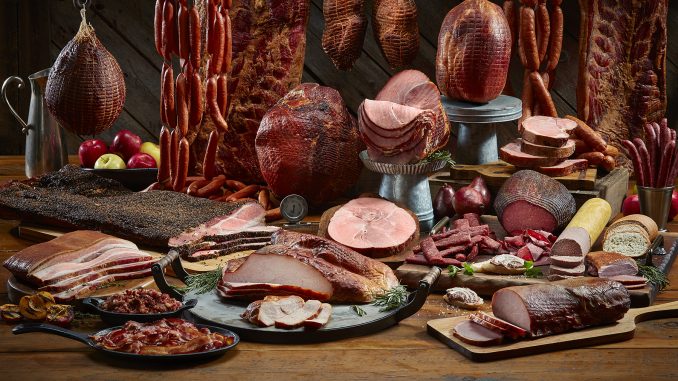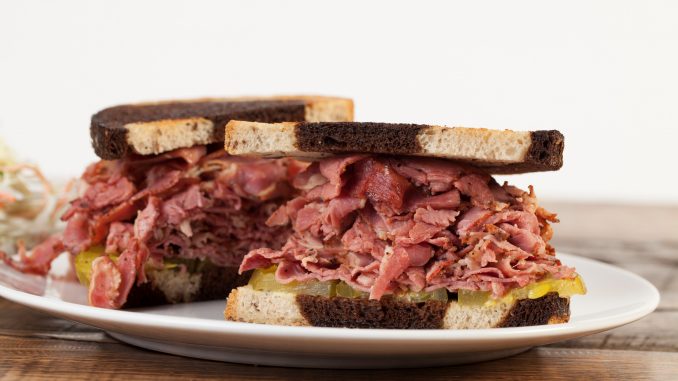Profit From In 2020’s Four Deli Meat Trends
December 2, 2019 | 8 min to read
The deli landscape is evolving rapidly, with deli lunchmeats accounting for nearly 18.3 percent of supermarket deli sales. According to Eric Richard from the IDDBA, adapting to consumer preferences, particularly in flavors and convenience, is essential. The demand for traditional and unique flavors like teriyaki and Mediterranean is growing, alongside comfort foods. Operators can capitalize on these trends to drive sales, especially as Millennials seek quick yet quality meal options for their families.

Say the word ‘deli’ and for many it’s the classic image of whole cured hams, long netted salamis and fat finger-like sausages hanging invitingly over glass fronted cases that comes to mind. Meats indeed are a cornerstone category in this perishable department. Today, deli lunchmeats represent nearly one-fifth, or 18.3 percent, of total supermarket deli sales during the 52 weeks ending Oct. 26, 2019, according to Nielsen Total U.S. Food data.
Yet, times are changing.
“The retail landscape is shifting more today than it has over the last 50 years,” according to Eric Richard, education coordinator at the International Dairy Deli Bakery Association (IDDBA), headquartered in Madison, WI. “Overall, I think we’ll continue to see an evolution of the deli, as operators seek to adapt to customers changing eating and lifestyles, and the deli meat category will certainly be a part of this.”
Here are four ways to capitalize on trends in flavor, convenience, authenticity and creativity to help sell more deli meats in 2020.
1. FLAVORS: TRADITIONAL & TRENDY WINS
In a Presidential Election year, the usual trends get skewed by the return to comfort food, says Jim Pierson, vice president of sales for the Pocino Foods Co., in City of Industry, CA. “We see the largest growth in salami and dried sausage, followed by ham and then turkey.”
Turkey is the Number One deli meat by dollar sales, according to Nielsen Total U.S. Food data.
“Our best-selling products include our Oven Roasted and Thanksgiving Style Roasted Turkey Breast products,” says Adam Grant, associate brand manager for retail deli for Butterball, headquartered in Garner, NC. “In 2019, we launched an extension to the Thanksgiving deli line with our Herb Roasted Thanksgiving Style Turkey Breast product, which features a topical herb seasoning that brings the savory flavor combination of holiday stuffing and oven roasted turkey to the table year-round.”
Ham ranks second in deli meat dollar sales, followed by salami, beef, chicken and bologna. However, a different order emerges based on percent year over year growth. That is, salami leads (+3.4 percent), followed by bologna (+3.2 percent), beef (+2.7 percent), turkey (+1.3 percent) and ham (+0.8 percent). Lunchmeat chicken experienced a 7.9 percent drop in dollar sales.
However, as consumers’ flavor preferences expand, there is a demand for unique, bold flavor offerings in the deli category. These flavors include ethnic and regional flavors, sweet and spicy, and bold, say manufacturers.
“Our team is leveraging recent research in our flavor innovation strategy for the bulk deli,” says Hilary Gerard, senior marketing manager, Cargill Protein North America, based in Wichita, KS. “Two key takeaways from that work are to prioritize ham and chicken varieties for flavor innovation, as these proteins performed strongest in consumer response, and that southern and southwestern flavors were most frequently preferred.”
More delis are offering pepper-coated and uncured bacons, according to Megan Dorsch, marketing manager for Nueske’s Applewood Smoked Meats, in Wittenberg, WI. “This is in part because black pepper is a classic, but has also been a hot flavor this year and, in the case of our uncured bacon, because of consumers’ interest in alternative ingredients.”
Teriyaki and Hatch Chili are among ethnic flavors emerging, says Pocino Foods’ Pierson. “Pork belly continues to explode due to being Keto-friendly, since ours is minimally processed and can be easily repurposed from barbecue to teriyaki sauce. Other deli meat best-sellers are Pastrami and Pepperoni. Pastrami is being repurposed into new recipes, for example, with a chimichurri sauce. Pepperoni continues to be a nice spicy and flavorful addition to any sandwich.”
Looking ahead, Mediterranean flavors are expected to grow in popularity, according to the Food and Flavor Trends 2020 and Beyond Global Trend Survey, presented by Les Dames d ’Escoffier International in October 2019. In addition, the survey suggests more exotic flavors from North Africa and the Middle East will gain attention. This offers inspiration for not only the manufacture of new products, but also trendy usage ideas for traditional deli meats.
“If supermarket delis do it right and offer both new flavors and high-quality classics, they’ll see huge growth as Millennials are raising families and want to feed them well, but have limited time for meal prep,” says Nueske’s Dorsch.

2. CONVENIENCE: THE NEED TO FEED TIME-STARVED SHOPPERS
The demand for convenience is driving change in today’s deli landscape. That said, one of the biggest trends in 2020 will likely continue to be grab and go, according to Butterball’s Grant. “With consumers looking for quick and convenient options, numerous retailers are beginning the transition of converting their dedicated bulk, service deli space into grab and go displays. This is leading to volume and dollar sales shifting from bulk deli to grab and go.”
Bulk, or deli meats sliced to order, still make up the majority (60 percent) of category sales versus pre-packaged (25 percent) and grab and go (14 percent), according to IRI market advantage data for the 52 weeks ending Aug. 11, 2019, as published in the IDDBA’s State of Deli Meat & Prepared Foods report, released September 2019. However, bulk deli meat dollar sales decreased ($163 million) over the last year, while pre-packaged and grab-and-go both increased, $34 and $192 million, respectively. The result is that convenience formats account for nearly 40 percent of deli meat sales.
“Grab-and-go solutions like pre-packaged sliced deli meats reduce labor for the retailer and allow shoppers to easily take from the case without waiting at the deli counter. Plus, there is more interest from Millennials and Gen Xers in the snacking, grab and go and entertaining categories, while Boomers are more likely to shop the full-service deli counter.”
Snacking and entertaining are indeed huge trends. In fact, nearly half (47 percent) of U.S. consumers snack everyday, according to the State of the Specialty Food Industry research, 2019-2020 edition, by the New York, NY-headquartered Specialty Food Association. Plus, half (50 percent) of Americans entertain guests at home at least once a month, and nearly one-quarter (21 percent) do so daily or weekly, according to results of a 2017 published online survey released by German market research group, GfK.
“We’ve seen delis begin stocking more of our bulk, traditional snack sausages right in the case, like Landjaeger—a rich, peppery Alpine-style snacking sausage, Beef Sticks, All-Beef Summer Sausage, and other shelf-stable sausage sticks that fit the desire for snacks and creating platters at home,” says Nueske’s Dorsch.
New premium snacking kits sold under Cargill’s Castle Wood Reserve brand contain rolled deli meat paired with a unique cheese and sides, like dark chocolate dried cherries or yogurt-covered granola clusters.
For snacking or entertaining, Piller’s Fine Foods’ 6-ounce Black Kassel-brand charcuterie trio includes the Brantford, Ontario-based company’s signature-shaped salamis: heart-shaped D’Amour, square/diamond-shaped mustard seed and flower-shaped Old Forest.
“The artisanal shapes lend themselves to elevated entertaining,” says Stephanie Eagan, director of marketing. “The retail-friendly trio is shelf stable, offering greater merchandising flexibility within the deli department or other areas of the store. The peggable trio can be displayed in or out of refrigeration in its retail-ready display box, baskets and more.”
3. AUTHENTICITY: TELL ‘EM & SELL ‘EM
Transparency is a huge selling point in delis today, according to the IDDBA’s Richard. “This encompasses everything from telling customers what’s in a product to how it’s made. It’s an especially important point for deli meats, since these are processed products.”
A cleaner label product is becoming more paramount and asked for, more than ever before, as the average shopper is becoming more educated, manufacturers say.
“The deli category hasn’t experienced much growth in the ABF (antibiotic free) or organic product space, but natural and clean-label, premium products have grown. To respond to this, we offer premium deli products with no nitrates or nitrites, no added hormones or steroids, made from whole turkey breast, and all our products bear the American Humane Certified seal,” says Butterball’s Grant.
For shoppers looking for a ‘better for you’ option, Piller’s Fine Foods is launching a 4-ounce All Natural Charcuterie Trio. This package offers three uncured salamis—Double Smoked, Spicy Hungarian and Black Peppercorn. All three flavors are minimally processed and contain no artificial ingredients, flavors or colors; no preservatives; no nitrates and nitrates added, and are made with pork raised with no added hormones.
Beyond the ingredient label, 93 percent of consumers think it’s important for brands to provide more detailed information about what is in a food and how it’s made, according to The Transparency Imperative 2018, published by the Vienna, VA-based Food Marketing Institute in partnership with Label Insight, headquartered in Chicago. What’s more, 74 percent of shoppers in 2018, compared to just 39 percent in 2016, said they’d switch from their usually purchased brand to one that provides more information than just what’s on the label.
“We have a growing handful of deli customers that have maps showing the locations of all their product suppliers on the wall—they’re a fun graphic to look at and familiar maps, like those of the U.S. or even of particular states, engage customers on a personal level. Maps give shoppers a way to relate to their purchases. It’s just such an effective, memorable way to show where food comes from,” says Nueske’s Dorsch.

4. CREATIVITY: SANDWICHES 2.0 & BEYOND
With the maturing Millennial generation able to spend more money than the Baby Boomers, the need for ‘something new’ more often is important for the retailer in providing new options, says Pocino Foods’ Pierson. “For example, take any sandwich and put it on a pretzel bun. Slice your roast beef into a chipotle Philly cheese sandwich.”
Restaurant-quality ways to use deli meats are one reason why Columbus Craft Meats offers high-quality whole muscle but not flavored meats, according to Evan Inada, charcuterie and partnerships director for Hayward, CA-based Columbus Craft Meats, a brand of the Hormel Foods Corp., headquartered in Austin, MN. “Shoppers want quality first in their deli meats, then they want to know what they can do with it. For example, five years ago no one really knew what to do with roast pork loin. Now, deli operators can cross merchandise the pork with, say, a Havarti or Brie, and apple chutney and the consumer can make sandwiches like what they could order out at a restaurant for double or more the price.”
Charcuterie is another big opportunity to upsell deli meats and much more, Inada adds. “Helping a deli customer choose maybe three good salamis, a pâté perhaps, two to three cheeses, a jam, berries or grapes and maybe some dark chocolate. That can quickly add up to a $75 to $100 basket ring.”
Both upscale sandwiches and trays lend themselves to customization.
Seventy-two percent of consumers today expect restaurants to accommodate customization requests, according to the 2019 Flavor Consumer Trend Report, from the Chicago-based market research group, Technomic.
“Deli meats can be used for many more applications, including salad and soup toppers, salad kits, in-store made upscale lunches or snacks and as a pizza topping. For example, we’re seeing an uptick in mortadella on pizzas. The new usage options for deli meats are endless,” says Columbus’ Inada. DB

